The Samsung Galaxy S10+ Snapdragon & Exynos Review: Almost Perfect, Yet So Flawed
by Andrei Frumusanu on March 29, 2019 9:00 AM ESTInference Performance: APIs, Where Art Thou?
Having covered the new CPU complexes of both new Exynos and Snapdragon SoCs, up next is the new generation neural processing engines in each chip.
The Snapdragon 855 brings big performance improvements to the table thanks to a doubling of the HVX units inside the Hexagon 690 DSP. The HVX units in the last two generations of Snapdragon chips were the IP blocks who took the brunt of new integer neural network inferencing work, an area the IP is specifically adept at.
The new tensor accelerator inside of the Hexagon 690 was shown off by Qualcomm at the preview event back in January. Unfortunately one of the issues with the new block is that currently it’s only accessible through Qualcomm’s own SDK tools, and currently doesn’t offer acceleration for NNAPI workloads until later in the year with Android Q.
Looking at a compatibility matrix between what kind of different workloads are able to be accelerated by various hardware block in NNAPI reveals are quite sad state of things:
| NNAPI SoC Block Usage Estimates | |||
| SoC \ Model Type | INT8 | FP16 | FP32 |
| Exynos 9820 | GPU | GPU | GPU |
| Exynos 9810 | GPU? | GPU | CPU |
| Snapdragon 855 | DSP | GPU | GPU |
| Snapdragon 845 | DSP | GPU | GPU |
| Kirin 980 | GPU? | NPU | CPU |
What stands out in particular is Samsung’s new Exynos 9820 chipset. Even though the SoC promises to come with an NPU that on paper is extremely powerful, the software side of things make it as if the block wouldn’t exist. Currently Samsung doesn’t publicly offer even a proprietary SDK for the new NPU, much less NNAPI drivers. I’ve been told that Samsung looks to address this later in the year, but how exactly the Galaxy S10 will profit from new functionality in the future is quite unclear.
For Qualcomm, as the HVX units are integer only, this means only quantised INT8 inference models are able to be accelerated by the block, with FP16 and FP32 acceleration falling back what should be GPU acceleration. It’s to be noted my matrix here could be wrong as we’re dealing with abstraction layers and depending on the model features required the drivers could run models on different IP blocks.
Finally, HiSilicon’s Kirin 980 currently only offers NNAPI acceleration for FP16 models for the NPU, with INT8 and FP32 models falling back to the CPU as the device are seemingly not using Arm’s NNAPI drivers for the Mali GPU, or at least not taking advantage of INT8 acceleration ine the same way Samsung's GPU drivers.
Before we even get to the benchmark figures, it’s clear that the results will be a mess with various SoCs performing quite differently depending on the workload.
For the benchmark, we’re using a brand-new version of Andrey Ignatov’s AI-Benchmark, namely the just released version 3.0. The new version tunes the models as well as introducing a new Pro-Mode that most interestingly now is able to measure sustained throughput inference performance. This latter point is important as we can have very different performance figures between one-shot inferences and back-to-back inferences. In the former case, software and DVFS can vastly overshadow the actual performance capability of the hardware as in many cases we’re dealing with timings in the 10’s or 100’s of milliseconds.
Going forward we’ll be taking advantage of the new benchmark’s flexibility and posting both instantaneous single inference times as well sequential throughput inference times; better showcasing and separating the impact of software and hardware capabilities.
There’s a lot of data here, so for the sake of brevity I’ll simply put up all the results up and we’ll go over the general analysis at the end:
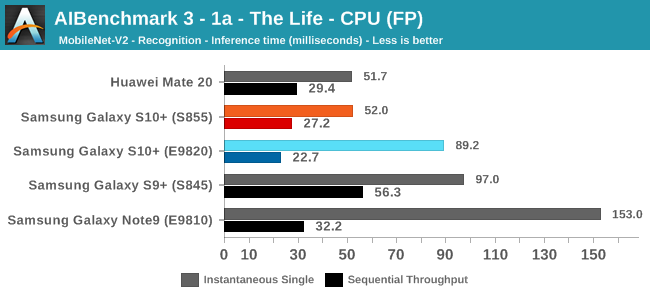
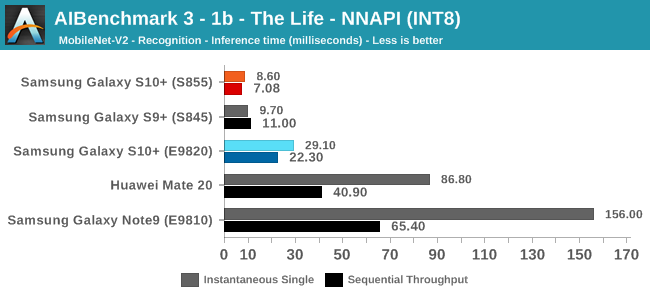
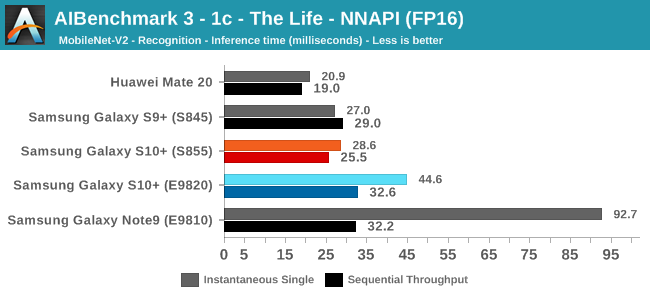

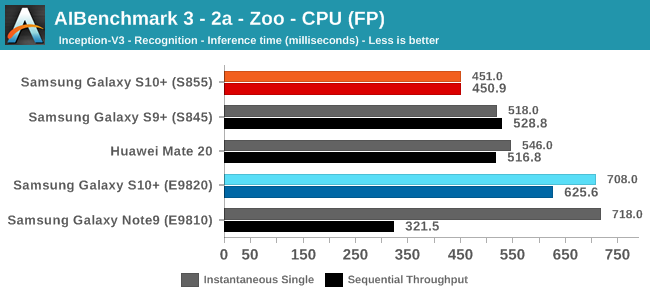
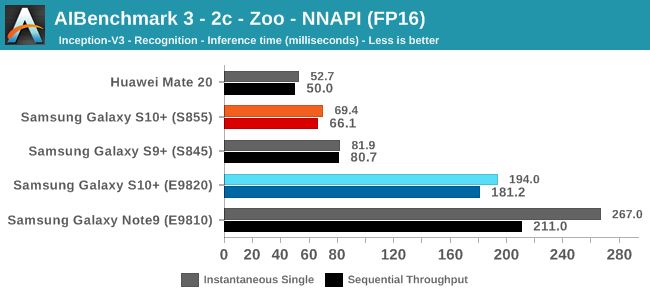
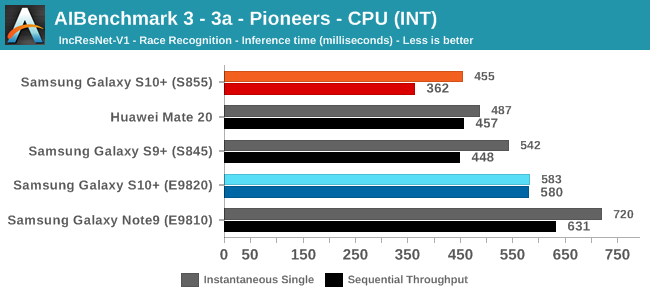
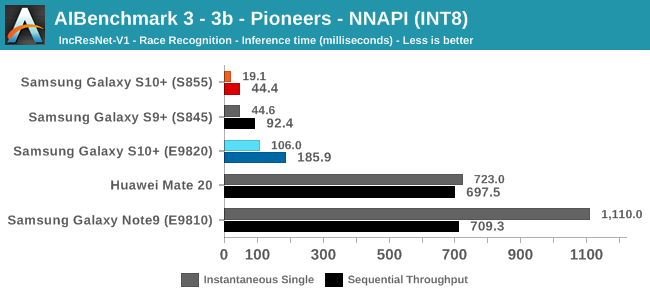
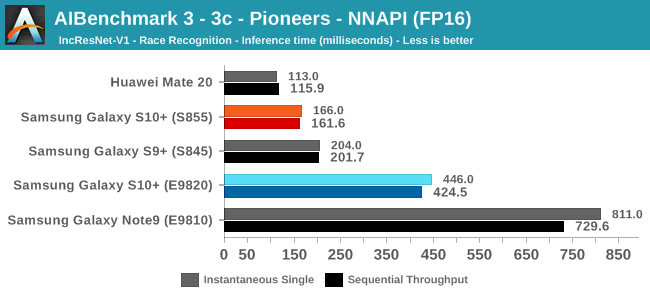

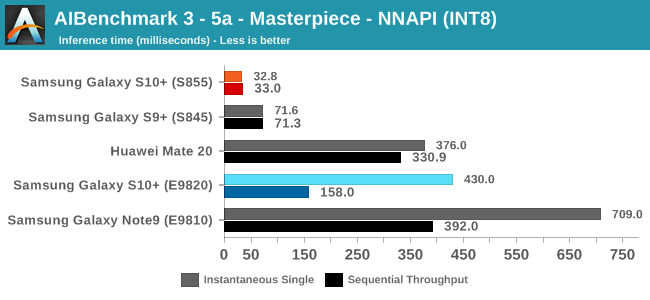
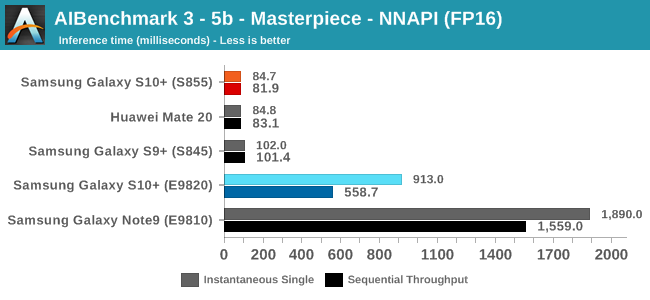
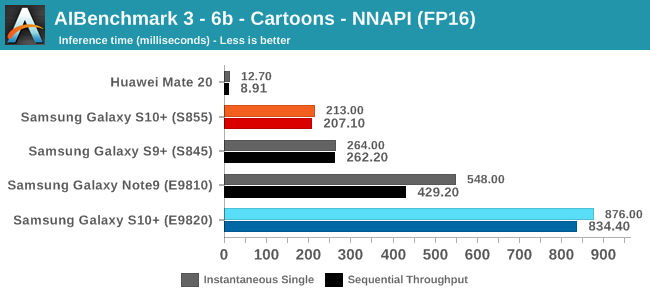






As initially predicted, the results are extremely spread across all the SoCs.
The new tests also include workloads that are solely using TensorFlow libraries on the CPU, so the results not only showcase NNAPI accelerator offloading but can also serve as a CPU benchmark.
In the CPU-only tests, we see the Snapdragon 855 and Exynos 9820 being in the lead, however there’s a notable difference between the two when it comes to their instantaneous vs sequential performance. The Snapdragon 855 is able to post significantly better single inference figures than the Exynos, although the latter catches up in longer duration workloads. Inherently this is a software characteristic difference between the two chips as although Samsung has improved scheduler responsiveness in the new chip, it still lags behind the Qualcomm variant.
In INT8 workloads there is no contest as Qualcomm is far ahead of the competition in NNAPI benchmarks simply due to the fact that they’re the only vendor being able to offload this to an actual accelerator. Samsung’s Exynos 9820 performance here actually has also drastically improved thanks to the new Mali G76’s new INT8 dot-product instructions. It’s odd that the same GPU in the Kirin 980 doesn’t show the same improvements, which could be due to not up-to-date Arm GPU NNAPI drives on the Mate 20.
The FP16 performance crown many times goes to the Kirin 980 NPU, but in some workloads it seems as if they fall back to the GPU, and in those cases Qualcomm’s GPU clearly has the lead.
Finally for FP32 workloads it’s again the Qualcomm GPU which takes an undisputed lead in performance.
Overall, machine inferencing performance today is an absolute mess. In all the chaos though Qualcomm seems to be the only SoC supplier that is able to deliver consistently good performance, and its software stack is clearly the best. Things will evolve over the coming months, and it will be interesting to see what Samsung will be able to achieve in regards to their custom SDK and NNAPI for the Exynos NPU, but much like Huawei’s Kirin NPU it’s all just marketing until we actually see the software deliver on the hardware capabilities, something which may take longer than the actual first year active lifespan of the new hardware.










229 Comments
View All Comments
Irish910 - Saturday, March 30, 2019 - link
Where is that website link that shows how many MORE times android tracked someone over iOS over the course of a day.....id4andrei - Sunday, March 31, 2019 - link
Google is pretty transparent about what it gathers and how it is using it. You can download at anytime anything relating to your metdata. You can wipe history of that data. You can disable tracking, personalized advertising and more. These controls are available to you in Android and your google account. This is one thing. Saying that Android has ads and has inherent security issues is another and it's plain bullshit. Saying that the Google store is the wild west is also bullshit.name99 - Friday, March 29, 2019 - link
"Exynos 9820 is the first tri-CPU cluster/group SoC which actually consists of three different CPU microarchitectures"It's not exactly comparable, but the A12/A12X has (at least) three different ARMv8 cores on it, the big cores (Vortex), the small cores (Tempest) and the tiny controller cores (but still ARMv8) Chinook. There are doubtless some number of M0s and suchlike ARMv7 cores also scattered around, but it's interesting that there are three different Apple-designed cores.
It's also interesting, in terms of area, to scan
https://en.wikipedia.org/wiki/Apple-designed_proce...
Notable comparisons, for example, are A9X vs A10 (nominally both 16mm FF, but A10 uses the resources more efficiently) and A10 vs A10X.
Andrei Frumusanu - Friday, March 29, 2019 - link
Oh come on you know better than this. The Chinooks are not part of the CPU cluster and aren't userspace program visible.I'm also not counting the Cortex A5's in the Exynos' audio and ISPs or the multitude of Cortex M3s it has.
name99 - Friday, March 29, 2019 - link
Don't want to argue about it; I just thought this was an interesting point :-)I'd be just as interested if we learned that QC (or ARM proper) were using ARMv8 devices (ie "interesting" cores, not tiny cores) to handle any of their "controller" type functionality, eg controlling the NPU or GPU.
tuxRoller - Friday, March 29, 2019 - link
I've not finished the article so perhaps you address these issues elsewhere."I wish Samsung at least would mimic the haptics with the fingerprint sensor."
Coupling haptics and an ultrasonic sensor that also looks beyond surfaces seem like it would be more difficult than just measuring capacitance.
Also, since the ultrasonic sensor works when the screen is off one should expect the apparent interaction time to go up. Did you happen to time it when the screen was on? The last scenario would be timing its unlock cycle when the phone is in use (any of the password managers should be fine).
Andrei Frumusanu - Friday, March 29, 2019 - link
> Did you happen to time it when the screen was on?I didn't do high-speed camera testing of it, but it does look every so slightly faster to respond.
tuxRoller - Saturday, March 30, 2019 - link
That's not too bad then. Most of the reviews I've seen haven't mentioned the new sensor being particularly slow, so, your experience stood out to me.name99 - Friday, March 29, 2019 - link
I don't know if the iOS 12.2 update had a change to scheduler or JS that has an important effect on web scheduling, but I got 124 for Jetstream 2 on my iPhone XS which is, of course, substantially better than the 98 that Andrei sees.FWIW I got a very similar number on my iPad Pro A12X, and on my iMac Pro (Xeon W turbos to 4.2 GHz) I got 142, which is remarkably close to the A12/A12X number...
tipoo - Sunday, March 31, 2019 - link
How nuts is it that for largely ST bound tasks like Javascript, the A12 hangs right in there with the Xeon W, which turbos to 4.2GHz.Scale up the core count and memory bandwidth and I don't see why anyone would assume that wouldn't be a very competent chip even for higher end systems, if the software for ARM support was there.